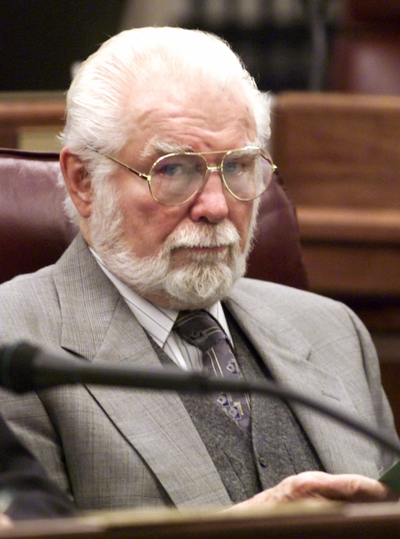Friday, March 13, 2015 | 2 a.m.
Harry Mortenson arguably was more scientist than politician, but he combined his skills as both an ecologically conscious nuclear physicist and dedicated longtime Nevada assemblyman to push through legislation that improved the state’s environmental conditions.
Mortenson was a tireless champion for the preservation of geologically historic Tule Springs in the extreme north end of the Las Vegas Valley, an outspoken opponent of the proposed nuclear waste repository at Yucca Mountain and a strong voice in the cause to prevent urban Southern Nevada from implementing the so-called “water grab” from rural Central Nevada.
Mortenson, a Democrat who served seven terms as the District 42 representative in the Nevada Assembly (1997-2009), died Wednesday in Las Vegas. He was 84. Mortenson recently developed heart issues and had been ill for a while, a friend close to the family said.
Services are pending.
“Harry was one of the good guys in nuclear science — he never sold out to the nuclear industry interests,” said former Las Vegas Sun environmental science reporter Mary Manning, who covered many of Mortenson’s key issues. “First and foremost, he was a true scientist.”
Manning recalled that when housing developments were being considered for Tule Springs, Mortenson and his wife, Helen, a longtime consultant specializing in nuclear, radiological and environmental issues, “fought tooth and nail” to preserve the 250,000-year-old bone fragments of such prehistoric creatures as Mammoths and giant sloths known to be at the site.
Working with the Center for Biological Diversity and the more than 300 members of the Protectors of Tule Springs, they were successful last December in getting President Barack Obama to sign documentation declaring the site as the Tule Springs Fossil Beds National Monument, forever preserving and protecting the area for research and other scientific studies.
On the lighter side of his public service work, Mortenson attempted — and failed — to get the acceptance of “Nevauhduh” as an alternate pronunciation of the state’s name.
Born Nov. 24, 1930, in Washington, D.C., Mortenson received his Bachelor of Science degree from the University of Maryland at Roanoke. He went on to study at American University and Catholic University before earning his master’s degree at Duke University. Mortenson did his doctorate studies at the University of Virginia but left before earning a degree.
He married the former Helen Wood in 1957 and eventually moved to Las Vegas where his work as a physicist included measuring radiation levels at the Nevada Test Site.
Mortenson also was board chairman and president of VIA, a local science consulting firm; past chairman of the Spring Valley Town Advisory Board and a member of the Los Alamos Scientific Laboratory staff from 1958 to 1962. He was a member of Sigma Pi Sigma, the physics national honor society.
Mortenson also was past chairman of the American Nuclear Society’s Southern Nevada chapter. He authored 14 scientific publications.
In 2004, Assemblyman Mortenson received a perfect score on environmental issues from the Conservation League. He left the Assembly five years later because of Nevada term limits.
In addition to his wife, Mortenson is survived by three children, Eric, Lisa and Kirk, and 12 grandchildren.
Editor's note: Because of incorrect information provided to the Las Vegas Sun, it was originally reported in this obituary that Mortenson worked at the Nevada Test Site measuring radiation levels. Although it was accurate that he measured radiation levels, he did not do that work for or at the Test Site.
Mortenson’s widow Helen says that her husband’s “legacy” was that, while working at Jackass Flats on the Nevada Test Site for the Los Alamos Scientific Laboratory, he developed the nuclear powered rocket that is designed to one day take man to Mars — the prototype of which currently is on display at the National Atomic Testing Museum on East Flamingo Road.
Also, because of inaccurate information in an on-line biography of Mortenson, his years of employment for Los Alamos were inaccurately reported. He worked for that scientific laboratory from 1962, the year he arrived in Las Vegas, to 1971, Helen Mortenson said.
Ed Koch is a former longtime Las Vegas Sun reporter.


Join the Discussion:
Check this out for a full explanation of our conversion to the LiveFyre commenting system and instructions on how to sign up for an account.
Full comments policy